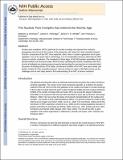| dc.contributor.author | Brohawn, Stephen G. | |
| dc.contributor.author | Partridge, James R. | |
| dc.contributor.author | Whittle, James Richardson Ross | |
| dc.contributor.author | Schwartz, Thomas | |
| dc.date.accessioned | 2012-11-01T20:04:02Z | |
| dc.date.available | 2012-11-01T20:04:02Z | |
| dc.date.issued | 2009-07 | |
| dc.identifier.issn | 0969-2126 | |
| dc.identifier.issn | 1878-4186 | |
| dc.identifier.uri | http://hdl.handle.net/1721.1/74557 | |
| dc.description.abstract | Nuclear pore complexes (NPCs) perforate the nuclear envelope and represent the exclusive passageway into and out of the nucleus of the eukaryotic cell. Apart from their essential transport function, components of the NPC have important, direct roles in nuclear organization and in gene regulation. Because of its central role in cell biology, it is of considerable interest to determine the NPC structure at atomic resolution. The complexity of these large, 40–60 MDa protein assemblies has for decades limited such structural studies. More recently, exploiting the intrinsic modularity of the NPC, structural biologists are making progress toward understanding this nanomachine in molecular detail. Structures of building blocks of the stable, architectural scaffold of the NPC have been solved, and distinct models for their assembly proposed. Here we review the status of the field and lay out the challenges and the next steps toward a full understanding of the NPC at atomic resolution. | en_US |
| dc.description.sponsorship | Pew Charitable Trusts (Scholars Program) | en_US |
| dc.description.sponsorship | National Institutes of Health (U.S.) (Grant GM077537) | en_US |
| dc.language.iso | en_US | |
| dc.publisher | Elsevier | en_US |
| dc.relation.isversionof | http://dx.doi.org/10.1016/j.str.2009.07.014 | en_US |
| dc.rights | Creative Commons Attribution-Noncommercial-Share Alike 3.0 | en_US |
| dc.rights.uri | http://creativecommons.org/licenses/by-nc-sa/3.0/ | en_US |
| dc.source | PMC | en_US |
| dc.title | The nuclear pore complex has entered the atomic age | en_US |
| dc.type | Article | en_US |
| dc.identifier.citation | Brohawn, Stephen G. et al. “The Nuclear Pore Complex Has Entered the Atomic Age.” Structure 17.9 (2009): 1156–1168. | en_US |
| dc.contributor.department | Massachusetts Institute of Technology. Department of Biology | en_US |
| dc.contributor.mitauthor | Brohawn, Stephen G. | |
| dc.contributor.mitauthor | Partridge, James R. | |
| dc.contributor.mitauthor | Whittle, James Richardson Ross | |
| dc.contributor.mitauthor | Schwartz, Thomas | |
| dc.relation.journal | Structure | en_US |
| dc.eprint.version | Author's final manuscript | en_US |
| dc.type.uri | http://purl.org/eprint/type/JournalArticle | en_US |
| eprint.status | http://purl.org/eprint/status/PeerReviewed | en_US |
| dspace.orderedauthors | Brohawn, Stephen G.; Partridge, James R.; Whittle, James R.R.; Schwartz, Thomas U. | en |
| dc.identifier.orcid | https://orcid.org/0000-0001-8012-1512 | |
| mit.license | OPEN_ACCESS_POLICY | en_US |
| mit.metadata.status | Complete | |
